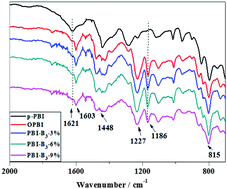Synthesis and properties of highly branched polybenzimidazoles as proton exchange membranes for high-temperature fuel cells†
Abstract
Highly branched polymers applied as low-temperature proton exchange membranes (LTPEMs) have attracted attention from researchers because of their outstanding properties. However, there are few reports on the use of branched polymers as high-temperature proton exchange membranes (HTPEMs). In this work, a series of highly branched polybenzimidazoles (PBIs) with 1,3,5-tri(4-carboxyphenoxy)benzene (B3) as a branching agent were designed and successfully synthesized for the first time. The highly branched PBIs were soluble in polar organic solvents and could be cast to form tough and smooth films. Compared with linear PBI membranes, the branched PBI membranes with a 9% degree of branching exhibited a high phosphoric acid (PA) doping level of 10.5 (PA molecules per repeat unit), high proton conductivity (0.043 S cm−1) at 180 °C under anhydrous conditions, high resistance to oxidation and good PA retention ability. All these properties indicate that branched PBI membranes are promising for HTPEMs and can be potentially used in HTPEM fuel cells.

- This article is part of the themed collection: 2016 Journal of Materials Chemistry C Hot Papers

 Please wait while we load your content...
Please wait while we load your content...